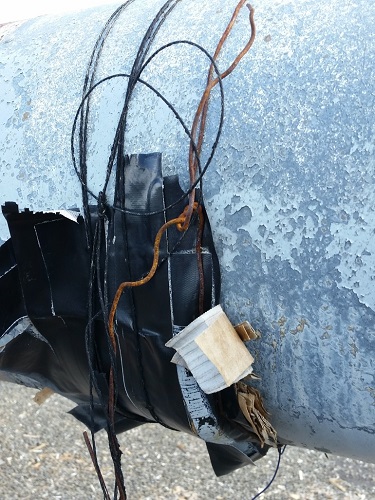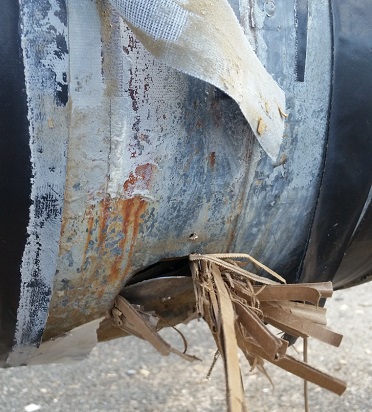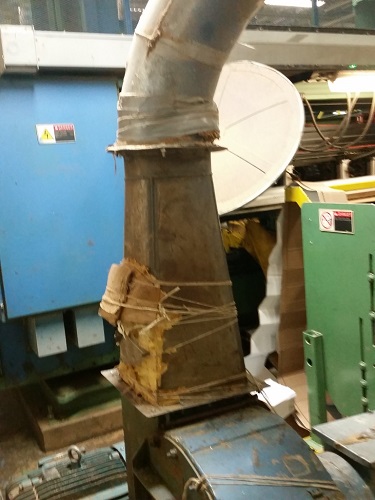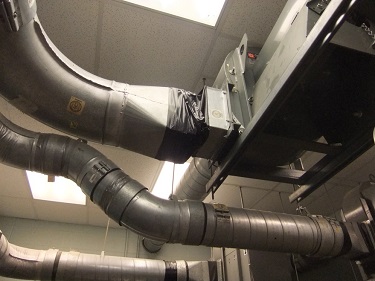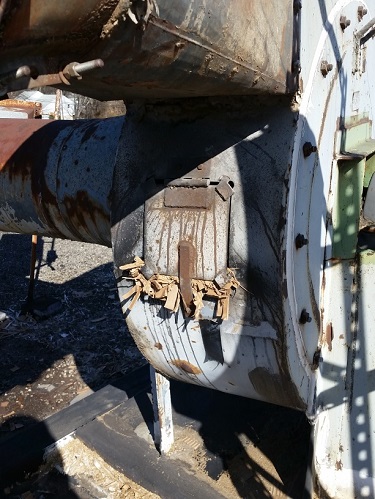Do you need professional duct repair?
Do you need professional duct repair?

Do you need professional duct repair?
Here are a few signs…..
The joy of a well-designed air system is, once up and running, it should always work. A switch is flipped and material is picked up from one end of a facility and deposited at the other end. Except for occasionally greasing the fan bearings, there isn’t much maintenance on a duct line. (Mechanical separators, balers, compactors, feeders, dust collectors etc.… is a topic for another day)
Alas even the best ductwork cannot withstand the ravages of time and use. It is not uncommon for ductwork to last 40 years or more, but it should be periodically inspected. Ductwork on the roof gets exposed to rain, wind, snow, ice, and hot sun. Ductwork under the roof gets hit by scissor lifts and forklifts. Support brackets may vibrate loose or get bumped. Pipes are subject to damage from foreign objects - scrap wood, tools, and trash – that get sucked through the line and dent or puncture all parts of the pipe as they go. The occasional clog will take its toll on ductwork as employees rush to disconnect, clear, and restart the system. (Hint: Clamp together ductwork works wonders)
Even after all that abuse, most ductwork systems continue to operate…but is it performing optimally, or quietly sucking up your profits? Maybe there was a jam when a Christmas party got a bit out of control. Santa’s outfit - boots and all - got sucked into the system (true story)! The next decade brought an occasional jam at product changes. Eventually issues started popping up every other month.
Stopping a multi-million dollar 24/7 corrugated or printing operation to locate and clear a clog in a line can be a tremendous source of frustration. When the system is working again, we tend to move to other priorities and not pay attention to the ductwork again until another catastrophe strikes. When small issues of infrequent clogging are dealt with, and they gradually become more frequent, downtime becomes the norm. Now the expense is more serious.
Costs quickly add up:
4 employees combating the clog at $75 per hour = $300 per hour
Average of 3 hours of finding, clearing, reassembling = $900
Downtime of equipment $2,500 per hour = $7,500
One clog may quickly cost $8,400.00 of profit!
Look at, identify, and analyze the costs of aging ductwork.
|
|
Elbows take the brunt of foreign objects entering the airstream. Small punctures will develop into large holes. This elbow has a patch of duct tape attempting to cover a 2” diameter hole. Because this is on the suction side of the ductwork, the tape got sucked into the system the moment the fan was turned on.
Math: 2” diameter hole is .0218 sf at 5,500 fpm equates to a loss of approximately 120 cfm, or roughly 3% loss in a 12” diameter ductwork, from a single point. |
|
|
Here is a puncture on a horizontal run. Possible causes: rust, a weak spot in the steel, or mechanical damage when handling. This hole is also causing a catch point on the inside from the jagged edges. Math: 3”x1 ½” hole is .0313 sf at 5,500 fpm and produces a loss of approximately 172 cfm, or roughly a 4% loss in 12” diameter ductwork. (Velocity down 7% with just two holes) |
|
|
This is a fitted seam between two pieces of ductwork. The temporary electrical tape joint is failing. Math: 11 ¾” x ¼” gap around a 1/3 of the ductwork. That’s .0204 sf. at 5,500 fpm, amounting to a 3% loss in cfm from a 12” diameter duct. (Collectively about a 10% loss in just these three points) |
|
The above designed system called for 5,500 fpm line speed, but small leaks slowed it down to approximately 5,000 fpm. This slowdown is outside of designed specifications, and has the potential to cause clogging issues in the line most notably during peak demands.
|
|
|
|
Featured here is a quick patch. Hopefully the offending material and catch points were removed prior to the “fix”. Materials used – duct tape, twine, baling wire. Air is still being lost through the patch as evidenced by the cardboard being pushed through the tape. With a catch point in your ductwork, it’s not a matter of IF, it is a matter of WHEN material will catch. A rotary die cutter in a box plant can easily make 30 cutouts per pass. Multiply that by 2000 passes/ hour or 60,000 cutouts per hour. If there is a one in a million chance that a cutout will get caught, one will be hitting that catch point every 16-17 hours. |
|
|
A patch on the positive pressure side of the ductwork, using only tape, was quickly blown off by the air pressure. The material is wedging itself in the cracks and slowly peeling the ductwork open like a soup can. The air loss is approximately 2% at this leak and growing. |
|
|
This ductwork has a slip fit joint that is reversed to flow. It encompasses the entire circumference of the duct causing catch points at the inside lip. Much like the examples above, material will wedge in these catch points and accumulate causing a choke point or a split in the duct. Always consider the direction of air flow to limit catching points! And yes, even more air is being lost. Combining the peeling areas and the circumference leak, there is currently about a 3% cfm loss. |
|
|
This picture shows a more valiant attempt to seal a hole. Materials used: rubber matting, roof matting, ratchet straps, 3 types of cording, twine, and baling wire. It is still leaking air. |
 |
All of these points were in a single duct run at a facility. In this run of 200+ feet there was a speed loss from 5500 to 3000 feet per minute. Typical NFPA line speed guidelines specify a speed of 3500 fpm for dust. Heavier materials require 5500 to 6500 fpm. Needless to say, the plant was plagued by frequent clogs and low productivity. |
|
Rooftop ductwork isn’t the only type that becomes worn with time. Ravages from the abuse dealt by man and machine inside the facility may be found.
|
|
|
|
Twine isn’t just for roof tops leaks! This type of damage in a fan transition is typical in a lot of facilities. Mechanical tools tend to be the culprit. A block of wood or piece of metal traveling 5,500 fpm out of a fan will dent, tear, and gouge transitions as well as elbows. In many facilities, it is common to hear a constant rattle of nuts and bolts being pulled through the air lines. |
|
|
This is a classic example of scissor lift or forklift carnage. Sitting 6’ high in a vertical position is not necessarily a safe zone. This ductwork still “works”, but causes additional Static Pressure and is a bit louder and a bit uglier. |
|
|
This ductwork was never really fit or repaired correctly after a plant change. These two pieces were connected with a heavy contractor garbage bag which required a new patch once a week for approximately 8 years. |
|
|
In addition to the suction side (above) the same type of patch is used on the positive pressure side. |
|
|
Ductwork isn’t the only item that can show the ravages of time. This fan boasts large gaps on a non-safety interlocked access door. The fan-to-duct transition has multiple grape-sized holes peppered throughout. It also can be opened without tools for a potential safety issue or OSHA fine.. |
|
Problems with an air system? We encourage you to take a walk around, use your scissor lift, and see how your ductwork is holding up. Can a constant hiss be heard at connecting joints? Is there damage to the ductwork such as cracks or holes? Is there a trim mess on the roof? It may be time to take action and start replacing that aging ductwork! Our specialists at Recycling Equipment Corporation can supply engineering, parts, or installations to restore your system to a reliable, cost effective, and energy efficient means of moving that material!
|
|
 |
|
 |
|




